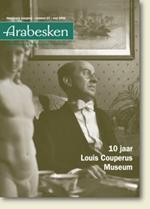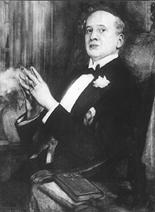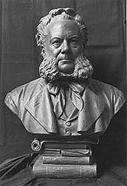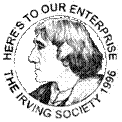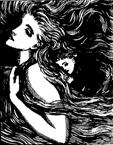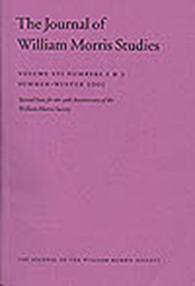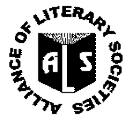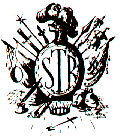THE
OSCHOLARS
___________
Vol. IV No. 2
issue no 33: February 2007
The society page
Reports on specialist societies divided into Hero Societies and Subject Societies.
New Societies are added each month. Last month we added Robert Louis Stevenson and Edith Wharton, and the Irish Society for Theatre Research; this month we add Henry James, Stephen Crane, the Irish Association of Art Historians and the Scottish Society for Art History. Next month we will add John Ruskin and Emile Zola.
News of Wilde Societies is in our main pages under the heading
Never Speaking Disrespectfully.
News of Shaw Societies
is in our Shavings
supplement, reached by clicking the cornet
French Societies will appear here from time to time, but in general are more likely to be found in the webpages of the Société Oscar Wilde under Links or Liaisons.
To Table of Contents
|
To hub page
|To THE OSCHOLARS
home page
.
Click for the main pages of this months edition of
THE OSCHOLARS.
Click on to see the entry; then on the Society's colophon or banner to reach its website.
|
Hero Societies |
|
|
|
|
|
|
|
|
Subject Societies |
|
We would very much like to receive news of similar Societies from anywhere in the world.
We will gladly publish the names of relevant articles from the Table of Contents of any of these Societies' journals if sent us as e-mail attachments.
I. HERO SOCIETIES
1. The Louis Couperus society
(Louis Couperus Genootschap)
The Louis Couperus Genootschap is the biggest literary society in The Netherlands.
Couperus, who firmly believed
in reincarnation, was convinced he had been an ancient Roman in a previous
life. His best work in this respect, The Mountain of Light, on the rise
and fall of the deified emperor Heliogabalus, became very popular in
The Societys website has recently been extended
Arabesken Number 28
28th issue of The Societys journal, Arabesken was published in November 2006. The Table of Contents is as follows:
|
Rémon van Gemeren |
Drama van de 'aangenaamste schrijver van de Nederlandse literatuur' |
|
Jan van Deursen |
'Eine hübsche Anlage zu einem
Werckgen' |
|
Erik Schoonhoven |
De essentie van verzamelen |
|
Caroline de Westenholz |
Heliogabalus en de Vlam van de Lust V |
|
Rieks Toxopeus |
Te koop: woonhuis van Louis Couperus |
|
Erik Schoonhoven |
De verschrikkingen van het alledaagse |
|
Caroline de Westenholz |
Inevitable |
Louis Couperus
[Eva Thienpont]
2. The Stephen Crane Society
Founded
by Crane scholar Paul Sorrentino in 1990, the Stephen
Crane Society is devoted to research on and discussion about the author. The
society grew out of a Crane conference sponsored by Virginia Polytechnic
Institute and
The society sponsors Stephen Crane Studies, a journal of notes, queries, bibiographical material, and reviews. The journal is published semi-annually in the spring and fall. Since 1992 it has been published at by the Department of English, Virginia Tech. Manuscripts should follow the MLA Style Manual . Annual subscriptions are $10 for individuals and $20 for institutions; foreign subscriptions are $12 and $22. Checks should be made payable to the Stephen Crane Society.
Address
all correspondence regarding subscriptions and manuscript submission to Paul Sorrentino, Editor, Stephen Crane Studies, Department
of English, Virginia Tech,
The Societys website, which contains much material devoted to Crane, can be reached by clicking the banner.
3. The Ford Madox Ford Society
This international society was founded in 1997 to promote knowledge of and interest in Ford Madox Ford's works and life. Ford, who disliked Wilde, is the link between Wilde and Violet Hunt.
The
Society aims to organise at least two events each year, and to publish one or
two Newsletters. The latest (
For
further information, either contact Sara Haslam (Treasurer) at
English Department,
The Societys very informative website can be reached by clicking on their banner below. A further hyperlink will bring up the Societys Newsletter.
o
We also refer readers to the
Ford pages at the
http://www.english.bham.ac.uk/fordmadoxford2006/literarycontacts.htm

4. The Housman Society
This
was founded in 1973 and exists to promote knowledge and appreciation of the
lives and works of A.E. Housman and other members of his family. The
Society also promotes the causes of literature and poetry in
general. It produces an annual Journal (index on line click their
logotype below), organises discussions, visits and poetry readings.
Commemorations are held in Bromsgrove on 26th March (A.E. Housman's birthday)
and in
The programme announced so far for 2007 is as follows:
80 New Road, Bromsgrove
ANNUAL GENERAL MEETING followed by Elizabeth Oakley talking about her current research into Clemence Housman.
Wine and Refreshments.
Monday
26th March
The Statue, High Street, Bromsgrove
A.E.H. BIRTHDAY COMMEMORATION
Followed by a Buffet Lunch (by kind invitation of the Chairman of Bromsgrove District Council).
A.E.H. COMMEMORATION
There will be a ceremony by the tablet on the north wall of St Laurences and this will be will be followed by lunch at a venue to be confirmed. The ceremony this year will be taking place on the actual day that A.E.H. died.
Hay-on-Wye
THE HOUSMAN LECTURE at The Hay Festival of Literature
The Name and Nature of Poetry
Dr Archie Burnett is Co-Director of the
Editorial Institute at
Friday 26th to
Housman Hall, Bromsgrove
SOCIETY WEEKEND
The opportunity to hold this weekend in Housman Hall, the Housman family home, will make it special. The programme is yet to be finalised but there will be tours of Housman Places in the area and a stimulating programme of talks, readings and discussion. It will include a concert (in conjunction with Bromsgrove Concerts) of Housman settings. Accommodation will be in The Ladybird Lodge, which is a recently built high quality hotel within a few hundred yards of the railway station.
Further details from info@housman-society.co.uk

5.
The Ibsen Society of America
To live is - to war with trolls
In the holds of the heart and mind.
The
Ibsen Society of America (ISA) was founded in 1978 at the close of the Ibsen
Sesquicentennial Symposium held in
The purpose of the Ibsen Society of America, as set out in its Bylaws, is to foster through lectures, readings, performances, conferences, and publications an understanding of Ibsen's works as they are interpreted in texts and produced on stage and in film and other media. The Society is The Ibsen Society of America by virtue of its location and the citizenship of most of its members, but it is concerned with Ibsen activities throughout the world. Membership in The Ibsen Society of America is open to anyone with an interest in Ibsen.
The ISA publishes an annual journal, Ibsen News and Comment, distributed free to all members, which reports on Ibsen activities within the ISA and throughout the world. It reviews productions of Ibsen's plays and recent books and articles on Ibsen. Every issue features the only existing critical annotated bibliography of current articles on Ibsen.
The journal is edited by
Joan Templeton, The Ibsen Society of
America, Department of English, Long Island UniversityBrooklyn Campus, One
University Plaza, Brooklyn, New York
If you click the masthead, you will arrive at a page (last updated 3rd March 2006) with a link that enables you to download as .pdf further information about the journals articles:
The Societys
meetings for 2006 took
place at the annual conference of the affiliate organization,
SASS (Society for the Advancement of Scandinavian Study) at the
The Ibsen Society site announces the
11th International Ibsen Conference, held in
Click
on the image to visit the Ibsen Societys website, last updated
6.
The Irving
The Irving Society was founded in 1996 to explore the life and times of Sir Henry Irving, the first actor to be knighted and the figure who, more than any other, raised the theatre to the status of a fine art. The complexity of his character, his mesmeric personality, his personal integrity and messianic intensity still fascinate us nearly a century after his death. The late Sir John Gielgud was a Founder Patron, and Sir Henry's great-grandson, John H.B. Irving, is a current Patron. Frances Hughes has succeeded Michael Kilgarriff in the chair.
The Society organises functions, trips, lectures, and meetings of various kinds five times a year, besides publishing a quarterly newsletter, The Irvingite, and a half-yearly journal, First Knight. The latest issue of The Irvingite )No 38 January 2007) is now published and can be downloaded as a .pdf file from their website.
The annual subscriptions (including publications) are Single - £20.00; Couples - £34.00; Overseas - £24.00 and can be sent (STERLING ONLY) to the Honorary Treasurer, Sylvia Starshine, THE IRVING SOCIETY, Flat 7, 23 Stanhope Road, London N6 5AW, England.
The next event is Sunday 11th February
Irving Statue,
Laying of the Birthday
Wreath
Concert Artistes' Association
Eleventh Annual General
Meeting
Richard Briers CBE and Nicholas
Smith 15.45
IN CONVERSATION
Moderator: Frances Hughes
Cutting of the Birthday Cake
16.30
Meeting
Closes
Admission to IN CONVERSATION Non-Members £3
For more details see the Societys website (click on the logo).
7. The Henry James Society
From their website:
Our mission is to offer Henry James scholars and other interested persons an opportunity to share in the study and appreciation of the life and works of the author. A non-profit educational organization, the Henry James Society provides a medium of communication for Henry James scholars and expands the possibilities for Henry James studies through annual meetings, special symposiums, and The Henry James Review.
The officers for 2007 are Tamara Follini, President (University of Cambridge); Eric Savory, Secretary/Treasurer (Université de Montréal); Julie Rivkin, Vice President (Connecticut College); Greg Zacharias, Executive Director (Creighton University); Susan M. Griffin, Editor The Henry James Review (University of Louisville). The Societys website, which is curiously lacking in complexity, can be found by clicking the picture of Henry James (the Society has no device of its own). For Henry James studies on the web, the reader is referred to the far more elaborate http://www2.newpaltz.edu/~hathaway/
8. The Arthur Machen Society
Machens dismissal from the London Evening News in 1921 was not solely due to the libelling of Lord Alfred Douglas in the premature obituary: the malaise, said Machen, had set in some time before. Machen told John Gawsworth why he believed he was not invited to contribute to The Yellow Book, the famous Nineties periodical: he had expressed enthusiasm for the Sherlock Holmes stories to the editor Henry Harland and felt this counted against him
The Friends Of Arthur Machen is a fellowship which exists to foster interest in Machen and his work, to aid research, and for the pleasure of its members. The Friends of Arthur Machen grew out of the remains of the British Arthur Machen Society, which was originally formed in the 1980s. The current membership of the Friends is very diverse, reflecting the very diverse currents which have drawn it together. Interest in mysticism, in the occult, in both paganism and Christianity, in the decadence of the 1890s, in the landscapes of Gwent, not to mention love of good reading and good living, are all very variously represented: in fact all that really unites the membership is admiration for a writer who has qualities not found elsewhere.
The Society publishes Faunus, the literary journal of the Friends, which has appeared twice yearly since the inauguration of The Friends and is now on issue 8. Contents are both articles of interest to admirers of Machen and examples of his work, often articles and pieces not easily available in any other form. Machenalia, the Friends' newsletter, is more informal, less literary in tone and style. It deals with items of topical interest, about Machen, and about the Friends. It too appears twice yearly.
Subscription: £20 or $36 (US). Send to:-
Jeremy
Cantwell, Treasurer, 78,
The
Annual General Meeting and Dinner will be held at the Three Salmons Hotel in Usk, Monmouthshire,
The website can also be reached by clicking the banner:
9. The George MacDonald Society
From their website:
George MacDonald (1824-1905) was one of the most original of nineteenth century thinkers. His writing and lecturing brought him wide recognition in his own day, and into the company of many of the leading Victorians of the time.
MacDonald's writing has an outstanding imaginative power, largely influenced by the German and English Romantics. It is in the realms of fantasy and children's literature, along with his visionary theology, that has made his greatest contribution.
The importance of George MacDonald's work is being rediscovered and the Society works to further this interest. Formed in 1981, it publishes an annual journal, North Wind which carries articles related to his life and work, reviews of new books, and other publications relevant to MacDonald Studies. For back copies of North Wind, please write to Mrs. Rachel Johnson, 18 Tappenhall Road, Fernhill Heath, Worcester, WR3 7TR, England; the most recent issue seems to have been that for 2003. A quarterly newsletter, Orts is also produced to provide news of events, meetings, lectures, or visits and any other information of interest to members: we do not know when the last one appeared.
A research collection of works on and by
MacDonald has been established at King's College,
Membership of the Society is open to all who are interested.
That
there are affinities here with Oscar Wilde is apparent; if they have
ever been explored, we have yet to learn of it.
The home page (last updated as long ago as
10. The Charles Rennie Mackintosh Society
The Charles Rennie Mackintosh Society is an independent, non-profit
making charity, established in 1973 to promote and encourage awareness of the
Scottish architect and designer, Charles Rennie
Mackintosh. The Society has over 1600 members across the world with active
groups in
In 1999, the Society
became owner and long-term custodian of the
A Mackintosh Festival
was held in
The CRM Society,
Queen's
The website (click below) has been redesigned. Its News & Events section can be accessed directly at http://www.crmsociety.com/eventlist.aspx, and one can now subscribe to an e-newsletter.
11.
Société Octave Mirbeau
Founded in
Website with all membership details and
much information about Mirbeau
http://membres.lycos.fr/octavemirbeau/
For
an early call for papers for an international Conference on Mirbeau,
see Being Talked About
Cahier 13, 2006 has been published, and with Dr Michels kind permission, we published the Table of Contents of its 352 pages in our issue for December 2006.
-----------------------------------------------------------------------------------#-------------------------------------------------------------------------------------
Bulletin à retourner à la Société Octave Mirbeau - 10 bis rue André Gautier,
Je
soussigné(e) : ___________________________________________
Courriel :__________________________
Adresse :___________________________________________________ _______________________________________________________________________
souhaite adhérer à la Société Octave Mirbeau pour lannée 2006, ce qui me donne
droit à la livraison annuelle des Cahiers Octave Mirbeau : 31 par an (étudiants et chômeurs : 15,50 ). Correspondants
étrangers : 38 .
souhaite
recevoir le tome I de la Correspondance
générale de Mirbeau : 35 (+ 4) :
souhaite
recevoir le tome II de la Correspondance
générale de Mirbeau : 40 (+ 4) :
Signature : Ci-joint un chèque de :
12. the William Morris Society
Founded in
The website has the following pages:
v
New in the
William Morris Society: Conferences, exhibitions, lectures, and
social gatherings in the
v Current US Newsletter: get involved with your Society!
v About the William Morris Society: Society bylaws, history, and membership directory.
v The Journal of William Morris Studies: The scholarly organ of the Society since 1961.
v The Life and Work of William Morris: Examples of and links to Morris's writings, poetry, and designs.
v The Worldwide Morris: Morris in English, Español, Català, Português, Россия, Magyar, Dutch, Dansk, Polska, Česky, Svenska, Deutsch, & Français.
v
Society
Archive: Worldwide announcements (1996 - present) and
v Links to Related Sites: Arts & Crafts · Printing & book arts · Products & services · Victorian links
The Journal
of William Morris Studies (formerly the Journal of the William Morris
Society) is edited by Dr. Rosie Miles, Editor JWMS, Kelmscott
House, 26 Upper Mall, Hammersmith, London, W6 9TA, England. Inquiries welcome:
the e-mail address can be activated by clicking on the image below. The
Journal (ISSN:
Between
* News of
Morris Society events in the
* Events and exhibitions related to the life and works of Morris and his associates.
* Calls for papers and essays for conferences and book collections.
* Biographical information and examples of Morris's works in many media.
* Books by and about William Morris.
* Products and services dealing with William Morris and his circle.
* Links to related web resources.
The 2007 programme is as follows (updated
13.
the William Morris Society of Canada
The
Societys most recent event was Shaw's Debt to Morris, a Lecture by Ivan Wise on
Future events are announced on their website and these and other information about the Society can be found by clicking the banner. At the moment of compilation of this months Society Page, events are listed as
~ February
2007 ~
Sweetness and Light: How Aesthetic Architecture Came to Ontario
~ March 2007 ~
The
WMSC Symposium
14. the William Morris Society of the United States
This Society is not currently maintaining its own website. The website of the (English) William Morris Society carries a link to the U.S. Society's Newsletter (July 2006). The Editor extends an invitation for anyone with Morris-related news, in the broadest possible interpretation, to contact her for inclusion in the next issue. "Morris-related" includes the Pre-Raphaelites, Arts and Crafts, History of the Book, Medievalism, Eco-Socialism, etc.
Also welcome are books for review, news of conferences, book sales, calls for papers, and news of tours.
Events are listed as follows:
through July 2007: Follow the
More from Shannon L. Rogers, Newsletter Editor, William Morris
Society in the
shannonr@ptd.net
![[Picture of William Morris]](IMAGE036.JPG)
William Morris and the Hammersmith Socialist League
15. The Robert Louis Stevenson CLUB
The RLS Club was formed in 1920 by those who had known Stevenson and who wanted to care for his memory.
The Club's main objective is to foster
interest in Stevenson's life and works. Over the years this has been met by
the organisation of exhibitions, lectures and readings, the presentation of
prizes for literary competitions, and the maintenance of the first
The Club, which has members all over the world, has close links with the RLS Club of Monterey, California, and is twinned with LAssociation sur le Chemin de RLS in the Cévennes, France.
The Club badge is based on the palm tree
device used on the famous Tusitala edition of RLSs
works in 35 volumes published by Heinemann in
The
RLS Club is a registered charity in
v The RLS Club is not to be confused with the (American) Robert Louis Stevenson Society, of which more in a future issue.
16. The Edith Wharton Society
Firmly grounded in
academe, the Edith Wharton Society offers Wharton scholars and other interested
persons an opportunity to share in the study and appreciation of the life and
works of this author. Through annual meetings, sessions, special
conferences, and its journal, The Edith Wharton Review,
the Society provides a forum for Wharton studies. The current President (2005-2007) is Donna
Campbell of
17.
The Alliance
The Alliance of Literary Societies was formed in 1973 as a result of a correspondence in The Times related to a threatened building with Dickens associations. Mrs. Kathleen Adams, Secretary of the George Eliot Fellowship, suggested that through a close cooperative literary society, societies could provide a more powerful voice in defence of the British literary heritage.
The
A journal is produced annually. Articles are welcomed by the editor, though she should be contacted before writing the article. The co-editors are Linda Curry, linda.curry1@virgin.net, and Robin Healey, robin@pitmaston.freeserve.co.uk. A Newsletter is also produced twice a year.
To contact the Alliance of Literary
Societies, please write or phone: The Secretary (Rosemary Culley) 22
II. SUBJECT SOCIETIES
18. The Society for the Protection of Ancient Buildings.
Founded by William Morris in 1877 to counteract the highly destructive 'restoration' of mediæval buildings being practised by many Victorian architects. Today it is the largest, oldest and most technically expert national pressure group fighting to save old buildings from decay, demolition and damage.
The Society's events calendar formerly found at http://www.spab.org.uk/noticeboard_events.html is now reached by a link from their home page (click their colophon).
February events are
Homeowners Weekend : London : 3rd-4th February
An
Introduction to the Repair of Old Buildings
Good As New Workshop 2007 : 16th February
Hull - Traditional
Roofing and Stonework Repairs
19. The Irish Association of Art Historians
Since
its foundation, the IAAH has maintained a programme of lectures, events,
seminars and tours to significant sites in
Financial assistance is given from time to time for research, publications and restoration projects and the IAAH funds an essay prize for History of Art undergraduates.
The
IAAH is also the representative association for art historians in
v Although the site promises quarterly updates on its news and events, the last event announced was for July 2004.
20. The Scottish Society for Art History
The
SSAH was founded in 1984 to promote Art History in
21.
the Arts & Crafts Society of New YorK
The Society's website maintains a number of fora dedicated to different aspects of Arts and Crafts, and its latest newsletter (Volume 8 Number 2 ) can be downloaded as a .pdf
22.
The Bedford
The Bedford Park
Society (a registered charity) was founded in 1963 to protect the amenities of
No events are ordinarily planned. The Society seeks to protect the amenities of the garden suburb and is therefore primarily interested in matters concerning the buildings, their setting, their maintenance and appropriate development sympathetic to their architectural and historic importance. The Society is not a residents association but is nevertheless keenly interested in community matters affecting the amenities of the suburb. The suburb has many buildings designed by Arts and Crafts Architects, including Voysey, Godwin and Norman Shaw.
The
23. The Decorative Arts Society
Founded in 1975, The Decorative Arts Society encourages the study
and appreciation of the applied arts, architecture and interior design on an
international basis throughout
In its activities and publications the Society embraces all the different media furniture, ceramics, glass, metalwork, textiles, jewellery and fashion as well as industrial design, stage and film design and the graphic arts.
Membership is international and is open to all who are interested in any aspect of this vast field. No specialist knowledge is required. Existing members comprise collectors, dealers, libraries, museum curators, teachers, students, artists and designers, as well as those from other walks of life, all of whom wish to share their enthusiasm with others. The DAS has an international reputation for its scholarship on the decorative arts which is disseminated world-wide through the annual journal, sent free of charge to all members. This illustrated publication contains authoritative articles based on original research usually collected around a particular theme or topic. With at least 100 pages and over 100 illustrations, many in colour, the Journal is of permanent scholarly value to both institutions and collectors. There is a full cumulative index of past Journals, most of which are still available. The current issue is number 30, and its Table of Contents is as follows:
·
Judith Crouch:
·
Donna Corbin: A Most
Exquisite Display: European Ceramics at the Centennial Exhibition
·
Max Donnelly and Brian D. Coleman: The
Colemans and Mintons Art
Pottery in British and American Collections
·
Max Donnelly: A Private
American Collection of American and European Decorative Arts,
·
Dr Ailsa Boyd:
The Decoration of Houses: The American Homes of Edith Wharton
·
Margaret Hall: The
remarkable encounter between George Walton and James Morton: designs for
Morton Sundour Fabrics Ltd
·
Robert Prescott-Walker: Conrad
Dressler in
·
Peyton Skipwith: Mitchell
Wolfson Jr.: Collecting for
the Wolfsonian
·
Dorothy Bosomworth: Albert
Paley Metalsmith Extraordinaire
Back numbers are
available through Richard
Dennis Publications, The Old Chapel, Shepton
Beauchamp, Ilminster,
For membership details contact The
Membership Secretary, Decorative Arts Society, PO BOX 136,
24. The Eighteen Nineties Society
This last candle of the Nineteenth Century has, regrettably been extinguished. The old web address of www.1890s.org now brings up a page with the message This page is parked free, courtesy of GoDaddy.com. The Victorian Society (q.v.) has a link to the Eighteen-Nineties Society, www.1890s.com, but this brings up a page of advertisements for Victoriana. Similarly www.1890s.co.uk is the page of a web development consultancy who specialise in the use of quality generic domain names. We also offer hosting for private clients that use our various business services, which sounds less than fin-de-siècle.
For a bibliography of the Societys publications, click here.
25. The Furniture History Society
1 Mercedes Cottages,
furniturehistorysociety@hotmail.com.
The small, and rather reticent, webpage that was at http://www.iserv.net/~plucas/fhsoc.htm no longer exists. A much grander site can now be found (click the banner below). Among the information given on its various pages we cite the following:
Furniture History, the journal of the Furniture History Society, is an
extensively illustrated scholarly journal issued annually to members only. It
is the only journal devoted to the history of furniture from all parts of the
world and is internationally recognized as authoritative. Subjects range from
the work of individual makers and designers to aspects of interior decoration,
domestic economy and trade practice. Contributions have been made by the
foremost scholars in the field, including Edward Joy on the overseas trade,
Robert C. Smith on Portuguese furniture, Helena Hayward on the designs of John Linnell, Georg Himmelheber on
nineteenth century German furniture, Geoffrey de Bellaigue
on the patronage of George IV, Svend Eriksen on neo-classical furniture, Morrison H. Hecksher on Philadelphia Chippendale, and Pierre Verlet on Parisian upholsterers.
From time to time, single issues devoted to individual subjects or notable articles published in special editions for sale to the public. Click Special Publications for a list of available back issues.
v January 2007: This link no longer functions.
The Furniture History Societys illustrated Newsletter, published four times a year, comprises about 24 pages of notices of
the Societys activities, news items and short articles on current matters of
interest, such as recent discoveries, research topics or museum acquisitions.
The Newsletter also reports on
past visits, lectures and study tours at home and abroad and includes numerous
book reviews.
v January 2007: The Societys website, reached by clicking the banner no longer leads to the Society, only to a list of recommended links.
v February: This has not changed. The links have little or nothing to do with Furniture History.
26. The Association of Historians of Nineteenth-Century Art
Founded in 1993, the Association of Historians of Nineteenth-Century Art currently has more than three hundred members. AHNCA's goal is to foster dialogue and communication among those who have a special interest in the field of nineteenth-century art and culture. Nineteenth-century art is broadly defined as all art that was produced between the American Revolution and the Paris International Exposition of 1900, regardless of geographic boundaries.
Current members in good standing receive two newsletters annually and a directory of association members. All memberships run from January to December of the calendar year in which you join or renew.
The Associations journal, Nineteenth Century Art Worldwide, has long been featured in the Publications section of THE OSCHOLARS.
Website (last updated 3rd March 2007)
27. The Irish Society for Theatre Research
The
Inaugural Symposium of The Irish Society for Theatre Research / Cumann Taighde Amharclannaíochta
na hÉireann will be held from Friday 13th April to
The field of Irish Theatre Studies is being transformed by new approaches to
the rich history of Irish theatre and by the remarkable diversity of
contemporary theatrical practice. The Irish Society for Theatre Research (ISTR)
is being founded in order to develop and promote new and challenging ways of
thinking about Irish theatre which engage with diverse contemporary
historiographical, theoretical, cultural
and performance frameworks.
ISTR aims to facilitate research on Irish theatre in its national and
international contexts in terms of an engagement with the broad spectrum of
Irish theatre from page to stage. ISTR will have a range of working groups
which currently include: Performance Studies; Theatre History and
Historiography; Cultural Identities; and Textual Practices. The current ISTR Steering
Group will be replaced in due course by an elected Executive Committee.
The process of establishing ISTR began with an open discussion at the
International Association for the Study of Irish Literatures (IASIL) conference
at Charles University, Prague, during July 2005. Since then the Steering Group of ISTR has met regularly in order to build the
necessary structures required to launch ISTR as a viable research society. The Steering Group of ISTR includes:
Dr Patrick Burke, St. Patricks College,
Drumcondra
Dr Ros Dixon, National University of Ireland, Galway
Dr Lisa Fitzpatrick, University of Ulster
Dr Eamonn Jordan, University College Dublin
Dr Cathy Leeney, University College Dublin
Dr Tom Maguire, University of Ulster
Prof. Anna McMullan, Queens University Belfast
Dr Paul Murphy, Queens University Belfast (Chair)
Dr Lionel Pilkington, National University of Ireland, Galway
Prof. Shaun Richards, Staffordshire University
Prof. Brian Singleton, Trinity College Dublin
Dr Bernadette Sweeney, University College Cork
Further information is available on the ISTR website: www.qub.ac.uk/istr. Please forward any enquires regarding ISTR to: istr@qub.ac.uk.
28. The Pre-Raphaelite Society
The Pre-Raphaelite Society is dedicated to the celebration of the mood and style of art which Ruskin recognised and preserved by his writings, and to the observation of its wide-ranging influence. In co-operation with societies of similar aims world-wide, it seeks to commemorate Pre-Raphaelite ideals by means of meetings, conferences, discussions, publications and correspondence, and to draw attention to significant scholastic work in this field. First and foremost, however, it is a society in which individuals can come together to enjoy the images and explore the personalities of the Pre-Raphaelites and their followers through the medium of fine art, the appreciation of good design and the excellence of the traditional arts. (Written for the Society by the late Anthony Hobson author of J W Waterhouse.)
|
Membership enquiries: Michael Wollaston 18 Floyd Grove Balsall Common CV7 7RP |
General enquiries: Barry Johnson Hall Green B28 8JB |
Programme:
The Society
organises a varied programme of lectures and visits to exhibitions and places
of interest each year. Please note that lecture events marked with an asterisk
* are
February 2007 (exact date not on website at 14th January)
The MacDonald Sisters *
Lecture to be given by Ina Taylor. Ina is a contemporary writer her bestselling publications include The Edwardian Lady: the Story of Edith Holden, plus Victorian Sisters. The lecture will consider the remarkable lives of the four MacDonald sisters, who were all connected through marriage with distinguished men of the nineteenth century.
The
Review of the PRS
First issued in the Spring of 1993, The Review has appeared three times a year (except in 1998, 2000 and 2003), when special issues on Burne-Jones, Ruskin and Millais each represented two numbers. Many of the issues are available for sale. Please contact for an order form. Tables of Contents of The Review of the PRS are published on the website, from Vol.1, No.1, Spring 1993 to the current issue, with reproductions of the covers. The series summarised on line has reached Vol. XIV, No. 3, Autumn 2006:
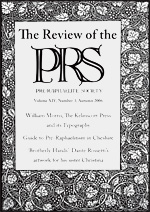
1.
William Morris, The Kelmscott Press and its Typography by Stephen Maddison the article focuses on the typography of the Press,
and how Morris successfully combined typography with illustrative ornamentation.
2.
Guide to
Pre-Raphaelitism in
3.
Brotherly Hands: Dante
Rossettis artwork for his sister Christina by Simon Cooke examines the
illustrations and bindings designed by Dante for his sister and the productive
collaboration which resulted.
29.
The
Association for Theatre in Higher Education
The Association for Theatre in Higher Education is an American organization of individuals and institutions that provides vision and leadership for the profession and promotes excellence in theatre education. ATHE actively supports scholarship through teaching, research and practice and serves as a collective voice for its mission through its publications, conferences, advocacy, projects, and through collaborative efforts with other organizations.
ATHE's 1,800 members include post-secondary faculty in theatre and related fields, graduate students, and theatre and performance artists in universities, commercial venues, and community-based and alternative theatres. Organizational members include theatre departments at colleges and universities, training conservatories, and many theatres.
Members receive a variety of benefits including subscriptions to publications, reduced rates at the national conference, a listing in the ATHE directory, a members-only e-mail list, and a chance to participate in specific interest groups.
The
website currently includes information on the 2007
Conference in
30. The Society for Theatre Research
Six
or more evening meetings are held monthly in
A very useful register of members research interests is on the Societys website.
The Society promotes further ad hoc activities for members and their guests. These have included Saturday Study-days, open to the public, when a topic is explored in depth by a series of speakers; day-trips to places of theatrical interest; and commemorative celebrations. 2007 programme has not yet (14th January) been published, but the Societys website can be checked by clicking on their colophon.
The Society also
* Distributes Theatre Notebook, an illustrated journal devoted to the history and technique of the British theatre, worldwide to members.
* Holds an annual Festival in memory of William Poel in which students from leading drama schools perform.
* Acts as an advisory body on theatrical matters and puts on occasional Study Days on particular aspects of theatre.
* Awards research grants to encourage work on theatrical subjects, especially those connected with live theatre.
· Awards an annual Theatre Book Prize for original research into any aspect of the history and technique of the British theatre.
Note added
31. The Victorian Society
The Victorian Society is the national society responsible for the study and protection of Victorian and Edwardian architecture and other arts. It was founded in 1958 to fight the then widespread ignorance of nineteenth and early twentieth century architecture. Among its thirty founder members were John Betjeman and Nikolaus Pevsner.
The programme is published.
Sunday 4th February
0703 A visit to the New West End
Synagogue. Regarded as the cathedral of
Anglo-Jewry, the New West End is the finest and most richly decorated of all
late Victorian synagogues. Constructed in
Monday 5th February
0701.4 Lecture: Guy Dawber. Fourth in our lecture
series on Edwardian Country Houses. Sir Guy Dawber
(1861-1938) is now largely overlooked by architectural historians but deserves
to be better known. Laurie Kinney will take an overview of his work, including
his time as President of the RIBA, his foundation of the Council for the
Preservation of Rural England and his winning of the Royal Gold Medal for
Architecture. He will also look at some of his houses together with other work,
including a church, a school and work at London Zoo. At the Art Workers Guild,
6 Queen Square, London WC1N 3AR. Doors open
Tuesday 13th February
0701.5 Lecture: Welbeck
Abbey and the 6th Duke of
Monday
19th February
0701.6 Lecture: Comfort and convenience
in the Edwardian country house. Sixth in our lecture series on Edwardian Country Houses.
What effects did new methods of water supply, sanitation, lighting and heating
have on the way in which space was used in Victorian and Edwardian country
houses? And how did the owners and their households respond? Marilyn Palmer,
Professor of Industrial Archaeology in the
Wednesday 28th February
0701.7 Lecture: Home and Colonial: the
houses of Edwin Lutyens. Last in
our lecture series on Edwardian Country Houses. During his lifetime
Edwin Lutyens was held to be our greatest architect
since Wren or, many maintained, his superior. Gavin Stamp, considers Lutyens and his clients, showing how he began with the
Surrey vernacular in houses such as Munstead Wood
(1895-7), but then responded to the taste for the monumental and the Classical,
leading to houses such as Heathcote (1905-3) and,
grandest of them all, the Viceroys house at New Delhi, completed in 1929. At
the Art Workers Guild, 6 Queen Square, London WC1N 3AR. Doors open
All attendance should
be preceded by contact with The Victorian Society, 1
For further details of the Societys programme, click the banner.
32.
The Victorian Society in America
The
VSA National Office,
Phone:
With its newly designed banner and website, the VSA (The only national non-profit organization committed to historic preservation, protection, understanding, education, and enjoyment of our nineteenth century heritage) seems to be well placed to increase interest in the period with a programme of events that can be found on its site. The Society publishes a scholarly magazine (19th Century; Editor: William Ayres), a printed newsletter (The Victorian; Editor: Edward Gordon), and a monthly email newsletter (Editor: John Cooper). Click the banner.
To Table of Contents |
To hub page
|To THE OSCHOLARS
home page
Click for the main pages of this months edition of
THE OSCHOLARS.
